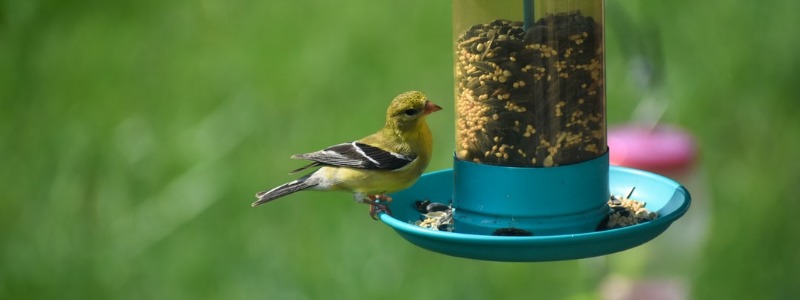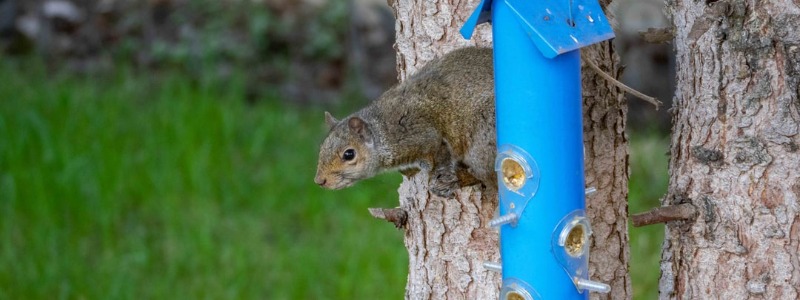Protect Birdfeeders in Your Yard
When you start feeding birds in your yard, expect some unwanted guests. Many species of birds and mammals enjoy not only the seed you are providing, but sometimes even the songbirds you are trying to feed.
Rodents such as rats, squirrels, and chipmunks, as well as raccoons, are the most common bird feeder pests. Some birds, dubbed “bully birds,” can be feeder pests because they eat all of the seed and act aggressively toward other birds trying to feed. Grackles, blackbirds, pigeons, and starlings are examples of these birds. Hawks, which prey on other birds at your feeder as well as smaller household pets, can also be a problem.
Bird Feeders and Bully Birds
Some birds like pigeons, jays, starlings, blackbirds and house sparrows will try to claim a feeder as their own. Try some of these tips if you find that the aggressive birds are taking over:
- To deter pigeons, eliminate corn, chicken scratch and grains from the feeder. Also, try placing a garbage can directly under the feeder.
- Most bullies are larger than the birds considered to be more desirable. By enclosing feeders with large-mesh hardware cloth or chicken wire, the smaller birds can pass through, leaving the larger birds excluded. There are also commercially made feeders just for this purpose.
- Sometimes it’s simply easier to put up several feeders. Keep seed the bullies don’t like in one and food they do like in another.
Protecting Bird Feeders from Hawks
If you already have a bird feeder, you’ve probably witnessed this sad and frightening scene. A bunch of feathers are strewn all over the place near one of your bird feeders, as if there was a major commotion. Even if you hope it’s just birds molting their feathers, you know that one of your prized backyard birds was snatched from the sky by a larger bird of prey.
Please remember that in Teas and the United States, it is illegal to kill, trap or harass native raptors. In addition to hawks, eagles and owls are protected by law. Try one of the following tips to help keep the songbirds your feeder will attract from becoming lunch for a hawk or kestrel:
- Place your feeder near shrubs or trees that will provide dense cover. Many people hang their feeders in trees to give the birds a greater feeling of security.
- Feed birds early in the morning and only what they will use in one day. Hawks and kestrels are more often seen later in the morning and in the early evening.
Protect Your Bird Feeders from Cats
Cats are responsible for the deaths of more songbirds than any other animal. Wild cats, also known as feral cats, typically hunt only at night. Domesticated cats cause the most harm to songbird populations because their prey is usually mice and other rodents. It is a common misconception that a well-fed cat will not kill birds or small mammals. In fact, they will still kill their prey instinctively.

A study conducted in San Diego County found that allowing cats to roam freely may have resulted in the extinction of several native birds, including the roadrunner, cactus wren, and California quail. According to a study conducted in the United States and the United Kingdom, an outdoor cat can kill up to 1,000 animals per year. Because it is nearly impossible to prevent a cat from chasing or killing birds, try some of the following methods:
- Don’t hang bird feeders from a fence where cats can get to it.
- Remove hiding places that a cat can strike from, such as low, dense shrubs. Or, you could plant thorny shrubs that the cats are less likely to hide in.
- Tie cut rose stems, thorny bushes, or barbed wire to feeder poles to keep cats from climbing the poles.
Protecting Bird Feeder from Squirrels
Squirrels love birdseed. They are often very hard to discourage. As George Harrison said in his book Squirrel Wars, “…it is a biological fact that squirrels have more time and a greater motivation (their own survival) to devote to the fight, regardless of how long it takes.”
Here are some tips to try to make it at least more difficult for squirrels to raid your feeder:
- Slip cut two-liter bottles onto your feeder’s pole. This will make the pole hard to climb.
- Place baffles underneath feeders.
- Move feeders away from trees where a jumping squirrel can reach it.
- Hang feeders from thick fishing line.
- Hang a feeder from a clothesline that is strung with small pieces of PVC pipe. When the squirrel tries to walk on sections of pipe, they will spin, sending the squirrel to the ground. This idea works well on support wires, too.
- Don’t put too much food in the feeder at one time. The birds will eat all of the food in the morning and leave nothing for the squirrels in the afternoon.
- Mix birdseed with cayenne pepper. It doesn’t bother the birds, but the squirrels will hate it.
- Use squirrel-proof feeders with weighted perches or cages to only allow small, light birds access to food or one like this:
Resources
- Nancarrow, Loren, and Janet Hogan Taylor. Dead Daisies Make Me Crazy. Ten Speed Press, 2000.
- Harrison, George H. Squirrel Wars. Backyard Wildlife Battles and How to Win Them. Willow Creek Press, 2000.
- Every Cat Should be an Indoor Cat – Educational brochure created as a joint project between Rancho Coastal

